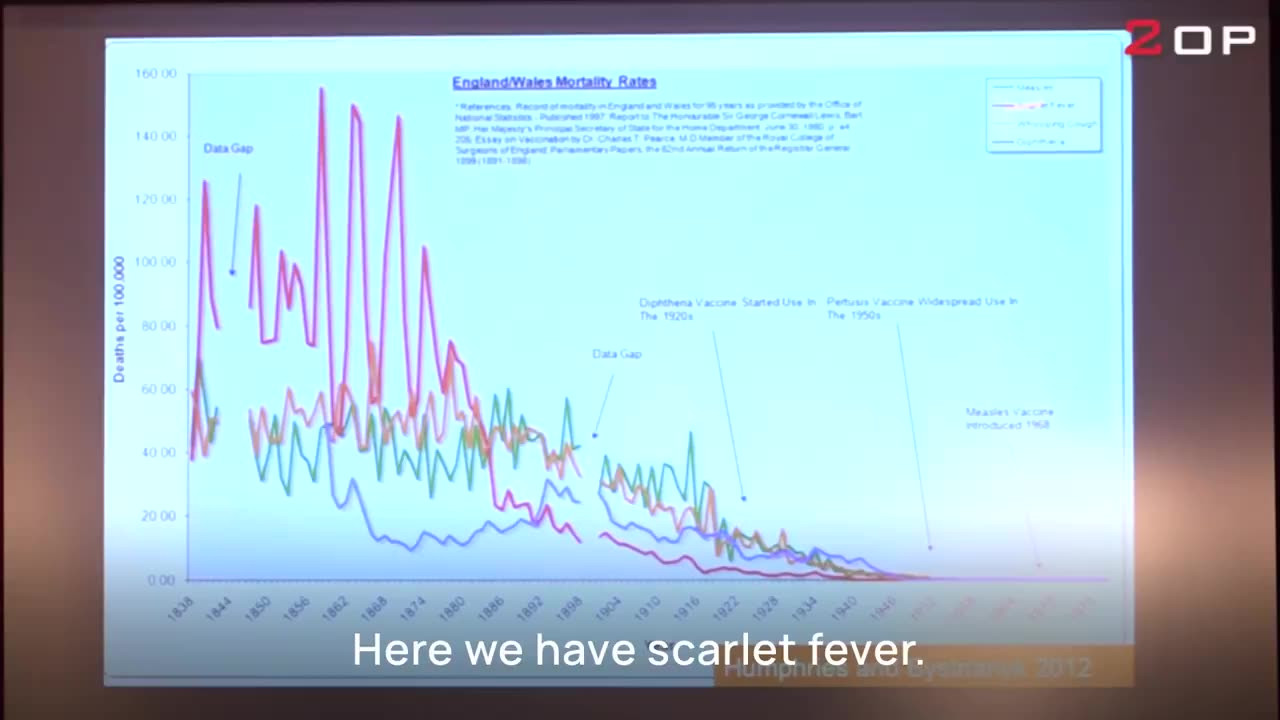Premium Only Content

Dr. Suzanne Humphries vaccines not responsible for declines in mortality from infectious diseases
🔥SHOW THIS ONE CLIP TO ANYBODY WHO SAYS "VACCINES" AND ANTIBIOTICS ARE RESPONSIBLE FOR DECLINES IN INFECTIOUS-DISEASE MORTALITY (because they 100% are not)🔥
Physician and co-author of Dissolving Illusions Dr. Suzanne Humphries describes how "vaccines"—as well as antibiotics—**have not been responsible for declines in mortality from infectious diseases.**
On the contrary, the declines have come from "advances in public health and safer lifestyles compared with that in previous centuries."
Humphries notes that we humans become more resistant to disease when we become "stronger." I.e. when our nutrition becomes better and we take better care of our bodies.
The physician highlights multiple charts showing that infectious diseases, such as measles, were on the steep decline **prior** to the introduction of "vaccines" for them. Indeed, in some cases, such as in the case of the Tetanus "vaccine," rates **spiked** following the rollout of the jabs.
Partial transcription of clip:
"So let's look back at a little bit of history. This comes from, doctor Nelson, infectious disease book from 2005, and this comes out out of a big institution in United States. And in this textbook, we have, a quote
that says that the decline in mortality from infectious diseases during the twentieth century stands as a tribute to advances in public health and safer lifestyles compared with that in previous centuries. And that's really what our book shows is that these changes in society and lifestyles and improvements in nutrition had more to do with the decline in death and in many cases with incidence of diseases than anything else including
antibiotic invention, including vaccination. As proof, I'd like to show you some infectious diseases.
"This is the year 1900. This is the year 1935 and this is the year 1970. Let's look at how the death rate went down for these diseases. Influenza and pneumonia claimed 202 per 100,000 in 1900 in United States.
In 1935, before there was any vaccine whatsoever, we were down by half. And by 1970, before the vaccination programs were really up, up and running, we're down even further. The original vaccines for influenza in USA, if you, look at the writing of a doctor named Doctor Anthony Morris who worked at the, Division of Biologic, Sciences which is now the National Institutes of Health.
His job was to determine the safety of these vaccines.
And he determined not only were they not safe in the 1970s, but were no more effective than tap water. And he testified to the this, effect, in front of the senate and, he was a qualified person to make that statement.
"Today, we are still offered these vaccines for influenza despite, despite, any real support for their effectiveness, despite any well designed studies for their safety, and despite the fact that the most prestigious, collaboration called the Cochrane Collaboration who evaluates, different aspects of medicine is saying that the hype and the media, information on influenza is completely out of proportion to the science. So let's look now at measles. We had 31 per 100,000 deaths in 1900 down to 2.7 long before the measles vaccine came in. And, I'll show you in a minute that it was almost down to 0 before the vaccine came on the scene.
"So I always thought that tetanus was, much more, prevalent than it actually was. But it turns out that look it's you don't even find tetanus on most charts like this because it was such a low incidence disease. So we had 4 per 100,000 back in the time when all these other things were claiming people's lives. And then by 1935 before tetanus vaccines, we had .95. so let's move on here and I'm gonna show you some more graphs in a minute. but I also want to show you a quote from, this article from 1980. And this doctor says that the death
rate from tuberculosis, diphtheria, scarlet fever, all
these other things, started to fall long before the introduction of vaccinations or antibiotics. And that's exactly what Roman and I found when we did our research looking at vital statistics in parts of world where they were available from the mid-1800s and onwards. This is another chart from our book and it shows you, the death rate in England and Wales from various diseases.
"So, let's look at measles. Measles is the green line.
And you can see the death rate for measles was, quite high, you know, around 40 per 100,000. And then it started to decline around the time when food was improving, child labor laws were being instated, and when, plumbers came on the scene and the sewage was separated from the drinking water. And look, here's when the measles vaccine came. Interesting, isn't it?
It was almost down to 0. We have the exact numbers, but it's like 0.3 or something like that.
"Here we have scarlet fever. Now scarlet fever vaccines were developed, but they found that they really only gave them to health care workers sporadically And
that, there were so many problems, with with these, vaccines, allergic reactions that they never really used them in mass production. But here we see a disease that so we can say they really never vaccinated the masses for scarlet fever. But look, death rate for scarlet fever. And it was down here a lot of people say, well that's because we have antibiotics, Doctor Humphries But antibiotics were created here, down here around the 19 there were some not so great antibiotics in the late 1930s late 1940s, and the early 1950s is when penicillin came. But you can see the death rate was down, because the people were stronger. And that's really important that the people being strong is much more important than the than the microbe being strong.
"Do you know that Bubonic Plague that used to take a quarter of the population and wiped out masses in Europe? Do you know we still have that in USA? You don't hear about it because not a lot of people are dying from it. Here we have, whooping cough and again, you see the same thing. Here's when whooping cough vaccine came in. So it's just silly to say that vaccination
is responsible for the decline in death rate. So let's get back to tetanus because we're often told that, you know, once we gave this vaccine we saw this enormous drop in deaths and and we're showing this graph here.
And it really does look like, you know, the tetanus vaccine came in around here and look we have this ski slope coming down. But the problem is and this is the
this is what how you'll be shown, by the public health authorities all the vaccine success. they don't show you the whole graph.
"Here's what happens when you look at the whole graph. we can see that it was already coming down and then it came down further. But look at how much more dramatic it was in England and Wales, and we can see that the the decline in in incidence of mortality is here
and the vaccine came in here. And we actually see it come up a little bit, after the vaccine came in. And this is the same thing, in Canada. You know, we see that, the death rate from tetanus, They only started reporting
cases here, but we can see the death rate was was just precipitously falling. And this is the year the vaccines came in. And again, we see for some strange reason an increase right there, but we can't say that we we have tetanus vaccines to thank because the the trend was already seriously coming down."
-
 2:58
2:58
Canadian Citizens Journal
7 days agoDr. Fauci and Bill Gates injected the World with HIV and Cancer 💉☠️💀
86 -
 LIVE
LIVE
BEK TV
23 hours agoTrent Loos in the Morning - 8/01/2025
253 watching -
 13:08
13:08
Dad Saves America
13 hours ago $1.53 earnedTeachers Unions Play Politics While Students Lag Behind - Poisoning of the American Mind: Pt 4
18K12 -
 20:05
20:05
Preston Stewart
13 hours ago $2.27 earnedCrimea Raid to Chasiv Yar Fight
20K9 -
 8:11
8:11
Millionaire Mentor
16 hours agoTulsi Gabbard and Leavitt DOUBLE-TEAM Kaitlan Collins in FIERY Exchange
16.1K6 -
 46:02
46:02
Coin Stories with Natalie Brunell
1 day agoWhat They’re Hiding About the Economy | Natalie Brunell with Danielle DiMartino Booth
49.4K13 -
 12:12
12:12
GritsGG
15 hours ago23 Warzone Wins in a Row! (Cypher AR)
90.1K3 -
 2:12:07
2:12:07
Side Scrollers Podcast
22 hours agoCULTURE SHIFT CAUSES MELTDOWNS + MASSIVE CENSORSHIP EFFORTS RAMP UP | SIDE SCROLLERS LIVE
31K12 -
 11:25
11:25
Nikko Ortiz
1 day agoMost Painful Fails
60.7K31 -
 43:55
43:55
pewculture
6 days ago $6.08 earnedIf the Purge was real, this is what we'd do... - EP#24
26.1K7